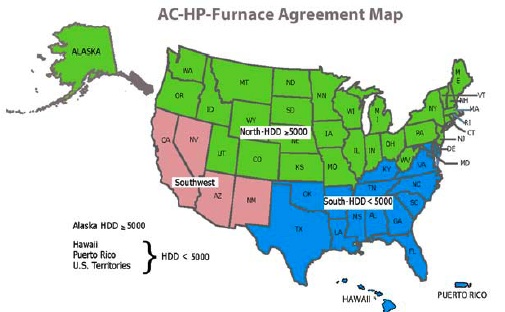Image Credit: Air-Conditioning, Heating and Refrigeration Institute; Alliance to Save Energy; American Council for an Energy Efficient Economy
Image Credit: Air-Conditioning, Heating and Refrigeration Institute; Alliance to Save Energy; American Council for an Energy Efficient Economy Federal minimum energy efficiency standards, where SEER = seasonal energy efficiency ratio; EER = energy efficiency ratio; HSPF = heating seasonal performance factor; and AFUE = annual fuel utilization efficiency. Performance-based codes will also allow 14 SEER/8.0 HSPF packaged systems and 81% AFUE weatherized gas furnaces, provided additional efficiency measures are installed to compensate for the difference in energy use between these systems and the corresponding regional values, as shown in the above table.
It’s rarely easy to get groups with disparate interests to collaborate, but an agreement announced this month between HVAC manufacturers and energy efficiency advocates illustrates that it can happen with potentially significant positive effects.
On October 13, the Air-Conditioning, Heating, and Refrigeration Institute, more than a dozen manufacturers, and seven energy conservation groups announced an agreement that calls for regional HVAC-product efficiency standards and more-stringent building code provisions for new construction.
The federal government has been slow to establish a new system of requirements that addresses the energy efficiency and cost-effectiveness of HVAC products in different climates. This agreement pushes the issue to a conclusion, although it still allows state governments to impose stricter standards for equipment installed in new homes “in which there are no physical restrictions to prevent or hinder installation” of the equipment.
On its website, the AHRI explains that the agreement establishes product performance requirements for three regions in the U.S.: the north (including Alaska), which has population-weighted heat degree days (HDDs) of 5,000 or more; the south, with HDDs of less than 5,000; and the southwest which includes Arizona, California, Nevada, and New Mexico.
A long-term plan
Factoring in the added cost of more-efficient equipment, the regional standards, which AHRI notes are allowed under the Energy Independence and Security Act of 2007, are expected to save consumers about $13 billion between 2013, when the standards take effect, and 2030. AHRI estimates that the new standards will raise the minimum efficiency of residential central air conditioning systems by about 8% and furnaces by about 13%. By 2030, those standards are expected to have reduced the overall heating energy load by 5% and the cooling energy load by 6%.
The energy efficiency advocates that signed the agreement include the American Council for an Energy Efficient Economy, the Alliance to Save Energy, the Natural Resources Defense Council, the Northeast Energy Efficiency Partnership, the Appliance Standards Awareness Project, the California Energy Commission, and the Northwest Power and Conservation Council. The signatories jointly sent the agreement to Congress for possible inclusion in climate legislation (the proposed American Clean Energy and Security Act is still making the rounds on Capitol Hill).
A realist’s approach
In terms of its long-range strategic merits, the agreement seems like a good thing for all concerned. As a recent New York Times story on the subject notes, the HVAC manufacturers not only have reached agreement on future product-performance standards and reached better terms than they might if they’d negotiated with the Department of Energy, they also have time to gear up to meet those standards.
“Being able to look at the agreements that are being put in place here allows us to put a template in place for the next 10 years, really,” Bob McDonough, president of residential and light commercial systems for Carrier, told the Times.
Weekly Newsletter
Get building science and energy efficiency advice, plus special offers, in your inbox.













0 Comments
Log in or create an account to post a comment.
Sign up Log in